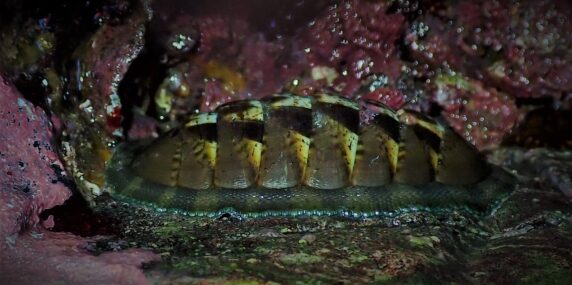Sea Cockroach, Chiton articulates
 Sea Cockroach, Chiton articulates. Chiton collected from coastal waters off Santa Rosalillita, Baja California Sur, August 2019. Collection, photograph and identification courtesy of Barry Mastro, Escondido, California.
Sea Cockroach, Chiton articulates. Chiton collected from coastal waters off Santa Rosalillita, Baja California Sur, August 2019. Collection, photograph and identification courtesy of Barry Mastro, Escondido, California.
The Sea Cockroach, Chiton articulates (Sowerby, 1832), is a member of the Chitonidae Family of Chitons. They are also known as the Articulate Chiton, Dog’s Tongue and the Marine Cockroach and in Mexico as cucaracha del mar. Currently there are sixty-nine known global members of the Chiton Genus.
The Sea Cockroach is large in stature, with an oval outline and a low profile. The shell has a smooth dull surface and the central dorsal surface varies from tan to orangish in color. The radial areas are grayish tan to slate brown in color, usually with darker, fine, radiating lines. They have broad, black bands running the length of the shell. Adults are often eroded or overgrown with coralline algae. Sea Cockroaches reach a maximum of 10.0 cm (3.9 inches) in length.
Sea Cockroaches are found intertidally, attached to rocks and in crevices. They range from Mazatlán, Sinaloa to Oaxaca, including the Revillagigedo Islands. The Sea Cockroach is the only chiton found in Mexican waters of the Pacific Ocean that are harvested commercially for human consumption. Overharvesting has markedly reduced the number of individuals in some regions.
Synonyms include Chiton laevigatus and Lophyrus striatosquamosus.